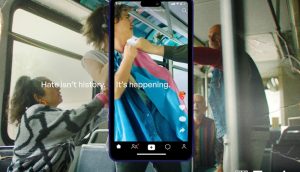McLuhan had it right. So right, it’s chilling. The medium is indeed the message, today more than ever – according to the largest ever global youth study, conducted recently by MTV, Nickelodeon and Microsoft.
Caroline Vogt, head of research, Microsoft Digital Advertising Solutions, EMEA & Americas, shared the study’s findings with a group of some 200 media-minded delegates attending strategy‘s Understanding Youth conference in Toronto yesterday. All were eager to learn how young people engage with digital technologies.
As part of her address, ‘Circuits of Cool,’ Vogt revealed that social networking is now an embedded lifestyle component for teens and tweens. According to the study, technology enables freedom, privacy, self-expression and connection with friends. ‘It’s very much their world, their space,’ she explained. Within this context, young people are ultimately relating to each other in a much deeper way, discussing topics they otherwise wouldn’t, sharing questions they otherwise couldn’t. ‘Friendships,’ said Vogt, ‘are more important than ever before to this generation.’
MiC sat down with Vogt to find out more about what all this means for media and the future generation in Canada.
What were the essential aims of this global youth study?
Vogt: ‘There’s a lot of research out there that looks at the fads, the emerging pockets of trends, but we wanted to go much deeper and broader in our understanding of youth. There are a lot of assumptions that this generation is dramatically different because of these technologies, and they’re spending all their time online. But we felt that there are a few myths being heralded by marketers that aren’t really the case.
‘So we went in with questions to address some of those myths – such as that it’s an isolated generation that prefers to communicate online to offline, that it’s a generation that doesn’t relate to linear TV content, and that it’s abandoned traditional media. We found out they weren’t true.’
What was the most surprising discovery in your research vis-à-vis Canadian youth?
Vogt: ‘They still value activities that have been popular for years. It’s still about being physically with friends, even though there are all these other ways to connect. They’re using them, but they still really value face-to-face time. And equally they still value listening to music. Watching TV is still incredibly important to them. They’re still engaging in all these things, so their top five activities would also have been the top five activities for [the previous generation].’
How does Microsoft plan to use the study’s findings?
Vogt: We’ve already been using it internally to help inform some of our product development strategies. In Europe, we already have Messenger TV, which is, within our Messenger IM tool, putting in some of our MSN video content and enabling it to be shareable. It’s rolling out into different markets [and launched in Canada in May. http://messengertv.msn.com].
What kind of content is fueling conversations online, professional or amateur? And what role do new platforms play?
Vogt: ‘This generation doesn’t care who produces it, they just want quality content. But when it’s UGC, it has much more value if you know who it’s coming from. So if it’s your friends at a concert, then that has more value to you than a random piece of user-generated content on YouTube. If you don’t know that person, you’re not as likely to share it.
‘With professional content, they value it if there’s strong narratives, if they can relate to it and if they’re a fan of it. They want to have that shared experience, and real advocates want to extend it across every screen.
‘But what’s interesting is that if you can deliver quality content to where they’re spending time, it can help fuel use of that technological device as well. It’s very much what MTV did with The Hills – extending the life and the relevance of one piece of content and making it available where these audiences are.’
Why do you say that content is communication?
Vogt: ‘Behaviour is more around short-form content at the moment, and ways to access different content screens and share that experience. When the TV screen is playing the content, the value you’re getting is from the content. But with online, physically you’re alone, but often you get content from your friends. Sharing links and forwarding things are incredibly prevalent among youth.
‘When we asked where do you get your online clips, it was equal between doing their own individual searches or getting links from their friends. Well, if they’re getting links from their friends, they’re getting messages from their friends, so the content has become a form of message.’
So for youth, information is coming more through social networks and less through traditional, mainstream media?
Vogt: ‘Yes. They value what their friends say, so when a message comes from them, they think, ‘OK, I’ll look at this.’ We’re beginning to see this among other people, but it’s much more prevalent among youth. Being part of the group is important to them, and sometimes you get that validation that ‘I want to be the one that shares the coolest thing.”
What would you say is the engagement or entry point into technology for Canadian youth today?
Vogt: ‘The big thing we found was when it taps into a personal and particularly a social need. So the ones that really took off were about facilitating social connection and particularly group connections, which networks obviously enable. And with free IM-ing [instant messaging], they can talk to groups or friends with privacy from their parents.’
What behaviour did you see in your research within Canadian youth?
Vogt: ‘With mobile, they’re more on par with the US than the rest of the globe, where they’re using more functionalities of the phone. And Canadians are more prone to using brand names.’
How would you describe Canadian youth’s interaction with technology?
Vogt: ‘In social networking, there’s a core motivation of being there because of music interest. But the other Canadian-specific trait is keeping in touch with friends and family from abroad, which we found when we looked at distinct motivations for using networks.’
You say social networking has been around for a very long time. How has it changed and how has it stayed the same?
Vogt: ‘I think social networking is just talking. So that part has pretty much stayed the same. What we talk about face to face is probably very similar to what we talk about on our mobile devices. In terms of social networking changing, we don’t have the physical barriers that we used to have, and it’s enabling us to connect with more people on more occasions. Before mobile phones, you would make a fixed arrangement to meet. Today, people never make proper arrangements because they know they can just text people and say they’re going to be late.
‘We’re trying to understand what they really value about being in these communications spaces, IM-ing or networking. Really what they get excited about and what they truly value is that they’re with their friends, as opposed to ‘I want to find out x, y, x, so I’m going into email or connecting with a certain friend.’ It’s really that sense of belonging that’s the overriding motivation for young Canadians.’























